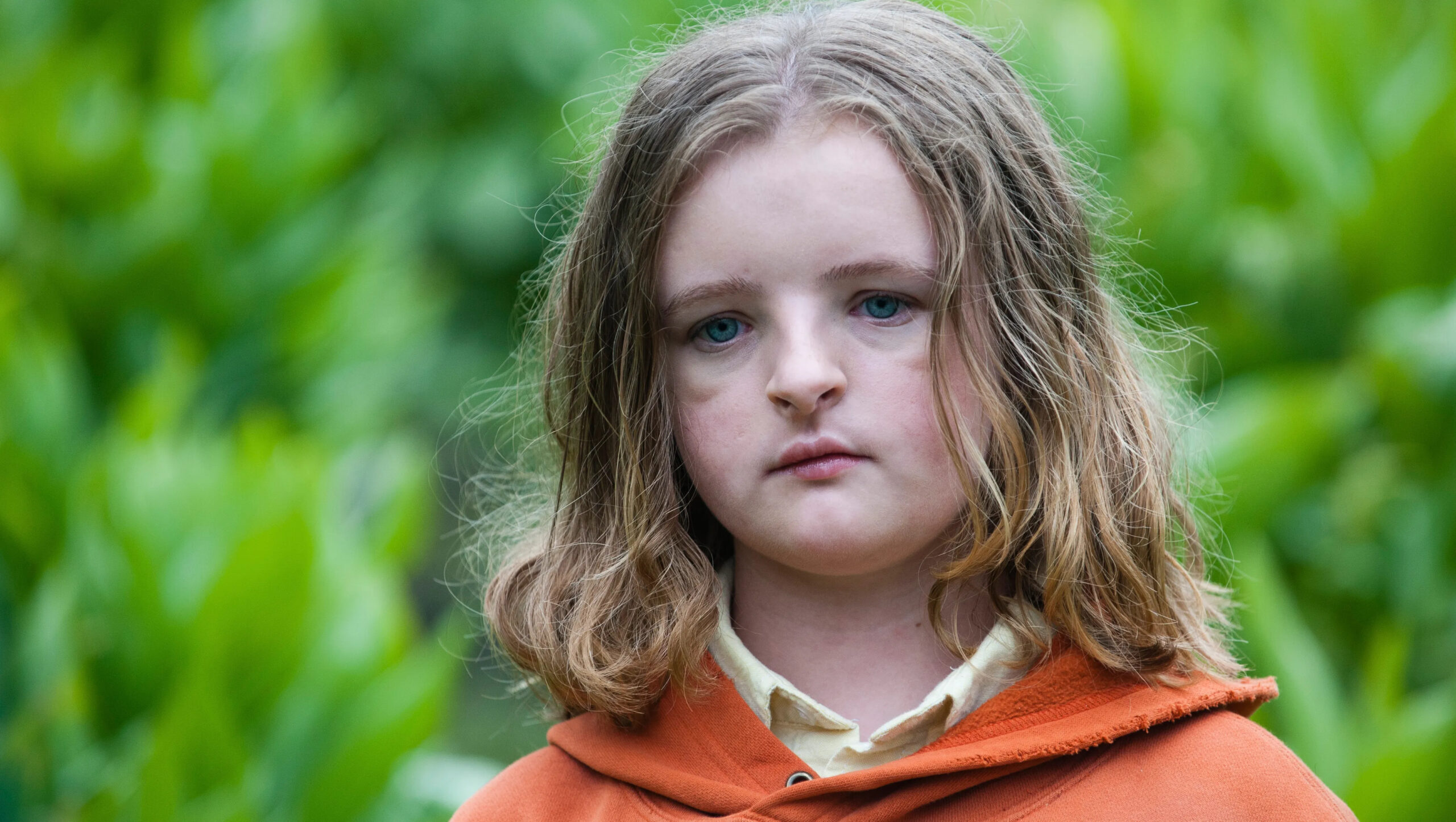“Hereditary,” directed by Ari Aster, is a psychological horror film that has redefined the genre with its intricate narrative, compelling performances, and unsettling atmosphere. Released in 2018, the film has received critical acclaim for its innovative storytelling and profound impact on audiences. This review delves deep into the various elements that make “Hereditary” a standout film in contemporary horror cinema.
Ari Aster’s debut feature film, “Hereditary,” isn’t just a horror movie—it’s a meditation on grief, trauma, and the inescapable nature of family legacy. By combining a deeply personal story with elements of the supernatural, Aster creates a world where psychological and metaphysical horrors intersect, leaving viewers questioning the nature of reality and the limits of human sanity. The film’s deliberate pacing, meticulous attention to detail, and relentless tension make it a masterclass in modern horror storytelling.
Watch It Here
- Gabriel Byrne, Alex Wolff (Actors)
- English (Subtitle)
- Audience Rating: R (Restricted)
- Brand New in box. The product ships with all relevant accessories
- Toni Collette, Gabriel Byrne, Alex Wolff (Actors)
- Ari Aster (Director) - Lars Knudsen (Producer)
- Spanish (Subtitle)
- Audience Rating: R (Restricted)
- Amazon Prime Video (Video on Demand)
- Toni Collette, Alex Wolff, Milly Shapiro (Actors)
- Ari Aster (Director) - Ari Aster (Writer) - Kevin Frakes (Producer)
- English (Playback Language)
- English (Subtitle)
Plot Summary
Opening and Family Dynamics
The film opens with an obituary notice for Ellen Taper Leigh, the estranged matriarch of the Graham family. The narrative focuses on the aftermath of her death and how it affects her daughter Annie (Toni Collette), her husband Steve (Gabriel Byrne), and their children, Peter (Alex Wolff) and Charlie (Milly Shapiro). The family dynamics are complex and strained, with each member coping with their grief in different ways. Annie, an artist who creates miniature dioramas, appears to have had a tumultuous relationship with her mother, Ellen, whose presence looms large even after her death.
The opening scene, with its meticulously crafted dollhouse and slow zoom into the Graham household, sets the tone for the film. This visual metaphor suggests that the characters are like dolls in a house, manipulated by unseen forces—a theme that will be explored throughout the film. The family’s interactions reveal underlying tensions and unresolved issues, particularly between Annie and her children. Peter is a typical teenager, detached and struggling with his own identity, while Charlie is an odd, introverted child with unsettling behavior and an eerie connection to her deceased grandmother.
Inciting Incident
The story takes a dark turn when Charlie dies in a horrific accident. During a high school party, Peter takes Charlie along, and she suffers an allergic reaction to nuts. In a desperate attempt to get her to the hospital, Peter speeds down a dark road, but Charlie, struggling to breathe, sticks her head out of the car window for air. In a shocking and gruesome moment, she is decapitated by a telephone pole. This scene is a pivotal moment in the film, not only for its shock value but also for the way it sets the stage for the family’s descent into madness and despair.
Peter’s reaction to the accident is one of numb shock. He drives home and goes to bed, leaving his parents to discover Charlie’s body the next morning. The film’s depiction of grief here is raw and unflinching, with Annie’s screams of anguish providing one of the most harrowing moments in recent horror cinema. This tragedy exacerbates the already fragile dynamics within the family, pushing each member further into isolation and despair.
Unraveling the Mystery
As the family grapples with their loss, Annie begins to uncover secrets about her mother’s past. She discovers that Ellen was involved in a secretive cult with ties to the occult. This revelation comes through a series of increasingly disturbing events, including apparitions, cryptic messages, and unsettling dreams. Annie’s descent into madness is portrayed with a harrowing intensity, as she becomes convinced that her family is being haunted by a malevolent force.
The film masterfully intertwines the family’s psychological struggles with the supernatural elements, creating a sense of dread and inevitability. Annie attends a support group for grief where she meets Joan (Ann Dowd), a seemingly sympathetic woman who later reveals herself to be part of the same cult as Annie’s mother. Joan introduces Annie to a séance, purportedly to communicate with Charlie, which leads to a series of increasingly terrifying supernatural occurrences.
Annie’s obsession with the occult grows, and she becomes more isolated from her family. Peter, meanwhile, is tormented by guilt and begins to experience his own haunting visions. Steve, the rational skeptic, tries to hold the family together but is increasingly helpless against the forces arrayed against them. The climax reveals that the family has been manipulated by these malevolent forces from the beginning, culminating in a horrifying and tragic conclusion that redefines the nature of their reality and seals their doom.
Character Analysis
Annie Graham
Toni Collette’s portrayal of Annie Graham is nothing short of extraordinary. Her performance captures the complexities of a grieving mother struggling with her own trauma and mental instability. Annie’s character is the emotional core of the film, and Collette’s portrayal is both powerful and nuanced. From her initial skepticism to her gradual acceptance of the supernatural, Annie’s journey is one of intense psychological horror.
Annie is an artist who creates miniature dioramas, a hobby that mirrors her own life in unsettling ways. These miniatures reflect her attempt to exert control over her environment, even as her life spirals out of control. Collette’s performance is marked by a raw, visceral intensity, particularly in scenes of emotional breakdown and confrontation. Her portrayal of Annie’s grief, paranoia, and ultimate surrender to madness is both sympathetic and terrifying.
Peter Graham
Alex Wolff delivers a compelling performance as Peter, whose guilt and trauma drive much of the film’s tension. Peter is a typical teenager in many respects, but the accident that kills Charlie shatters his sense of normalcy and plunges him into a nightmare from which he cannot escape. Wolff captures Peter’s vulnerability and growing desperation with remarkable subtlety, making his character’s descent into terror and madness deeply affecting.
Peter’s relationship with his mother is fraught with tension and unresolved issues, which are exacerbated by the tragedy. His attempts to seek solace in friends and substances only deepen his isolation. As the supernatural elements become more pronounced, Peter’s psychological state deteriorates, leading to a series of horrifying and traumatic experiences that culminate in a tragic and horrifying conclusion.
Charlie Graham
Milly Shapiro’s portrayal of Charlie is haunting and memorable. Charlie is an unusual and enigmatic character, whose peculiar behavior and unsettling presence contribute significantly to the film’s eerie atmosphere. From her strange clicking noises to her disquieting drawings, Charlie’s character is a focal point of the film’s supernatural elements.
Even after her death, Charlie’s presence looms large, symbolizing the inescapable nature of the family’s curse. Shapiro’s performance is subtle yet impactful, making Charlie a haunting figure whose influence extends beyond the grave. Her character serves as a catalyst for the film’s events, and her tragic fate is the fulcrum around which the narrative pivots.
Supporting Characters
Gabriel Byrne as Steve provides a grounding presence amidst the chaos, embodying the rational perspective that contrasts with Annie’s descent into madness. Steve’s character is the skeptic, the one who tries to hold the family together despite the growing evidence of supernatural interference. Byrne’s performance is understated but effective, providing a counterbalance to the escalating horror.
Ann Dowd’s portrayal of Joan is another standout performance. Joan initially appears as a supportive and understanding figure, but as her true motives are revealed, she becomes a menacing presence. Dowd’s ability to shift from comforting to threatening adds a layer of complexity to the narrative, making Joan a key figure in the unfolding horror.
The supporting cast, including Ellen Taper Leigh (as portrayed in flashbacks and photographs), enhances the film’s exploration of grief, manipulation, and the supernatural. Each character’s interactions and relationships contribute to the overall sense of dread and inevitability that pervades the film.
Themes and Symbolism
Grief and Trauma
“Hereditary” delves deep into the themes of grief and trauma, portraying how the death of a loved one can unravel a family’s stability. The film’s depiction of mourning is visceral and unflinching, making it a poignant exploration of human emotion. Annie’s grief over her mother’s death, followed by the devastating loss of Charlie, drives much of the narrative.
The characters’ different ways of coping with grief—Annie’s obsession with the occult, Peter’s guilt and isolation, and Steve’s attempts to maintain normalcy—highlight the profound impact of trauma on individuals and families. The film does not shy away from showing the raw, painful reality of loss, making the horror elements even more impactful.
Family Legacy and Inheritance
The movie examines the concept of inheritance, both in terms of genetics and the transmission of trauma. The Graham family’s curse is not just supernatural but also psychological, passed down through generations. This theme is reinforced by the film’s title, “Hereditary,” suggesting that the family’s fate is inescapable.
Ellen Taper Leigh’s involvement in the occult and her influence on her descendants are central to the film’s plot. The idea that the family is doomed by forces beyond their control adds a layer of existential horror. This theme of inescapable destiny is reflected in the film’s structure and symbolism, with the dollhouse motif representing the characters’ lack of agency in their own lives.
The Occult and Supernatural
The occult elements of the film are intricately woven into the narrative, creating a sense of impending doom. The supernatural occurrences are not just for shock value but serve to enhance the story’s exploration of control, manipulation, and destiny. The film’s depiction of séances, possession, and demonic rituals is both terrifying and thought-provoking.
Annie’s discovery of her mother’s involvement in a cult and the subsequent supernatural events reveal a hidden world of dark forces and malevolent entities. The film blurs the line between psychological and supernatural horror, leaving the audience questioning the nature of the events they are witnessing. This ambiguity adds to the film’s depth and complexity, making it a compelling study of the human psyche and the supernatural.
Mental Illness
The film blurs the line between supernatural horror and psychological thriller, often leaving the audience questioning whether the events are real or manifestations of mental illness. This ambiguity adds to the film’s depth and complexity, making it a compelling study of the human psyche. Annie’s family history of mental illness, including her mother’s dissociative identity disorder and her brother’s suicide, adds another layer to the narrative.
The possibility that Annie’s experiences are influenced by her own psychological state rather than supernatural forces creates a dual narrative, where both interpretations are equally valid. This exploration of mental illness and its impact on perception and reality is one of the film’s most compelling aspects, adding a layer of psychological depth to the horror elements.
Cinematography and Direction
Visual Style
Ari Aster’s direction is meticulous, with every frame contributing to the film’s oppressive atmosphere. The use of wide shots and slow zooms creates a sense of isolation and entrapment, reflecting the characters’ psychological states. The dollhouse motif, mirrored in the film’s production design, symbolizes the family’s lack of control over their own lives.
The visual style of “Hereditary” is both striking and disturbing. Aster’s use of static shots and deliberate pacing creates a sense of unease, allowing the tension to build slowly and inexorably. The camera work often mirrors the characters’ perspective, immersing the audience in their experience and heightening the sense of dread.
Lighting and Color Palette
The film’s lighting and color palette play a crucial role in establishing its mood. The muted colors and dim lighting create a somber and eerie ambiance, enhancing the horror elements. The use of shadows and darkness is particularly effective in building tension and suspense.
The lighting design often uses natural and low-key lighting to create a sense of realism and intimacy. The contrast between light and shadow is used to highlight the duality of the characters’ experiences, with moments of brightness often followed by plunges into darkness. This visual contrast mirrors the film’s thematic exploration of the boundary between the known and the unknown.
Sound and Music
Colin Stetson’s score is a haunting accompaniment to the film’s visuals. The dissonant and unsettling music heightens the sense of dread, while the sound design, including the use of silence, adds to the overall tension. The auditory elements of “Hereditary” are as impactful as the visual ones, making the viewing experience immersive and terrifying.
The film’s sound design is meticulous, using ambient noises and subtle audio cues to create a sense of unease. The use of silence, punctuated by sudden, jarring sounds, enhances the impact of the horror scenes. Stetson’s score, with its eerie, discordant tones, underscores the film’s themes of madness and supernatural dread.
Impact and Legacy
Critical Reception
“Hereditary” has been lauded by critics for its innovative approach to horror and its emotional depth. The film’s ability to blend psychological and supernatural elements has set a new standard for the genre. Toni Collette’s performance, in particular, has been highlighted as one of the best in horror cinema.
Critics have praised Aster’s direction and the film’s meticulous craftsmanship. The film’s willingness to tackle complex themes and its refusal to rely on conventional horror tropes have been noted as significant contributions to the genre. “Hereditary” is seen as a landmark film that pushes the boundaries of what horror can achieve.
Audience Reactions
The film’s reception among audiences has been equally impressive, though it has also sparked debates about its ambiguous ending and complex narrative. “Hereditary” is a film that demands multiple viewings to fully appreciate its intricacies, making it a lasting entry in the horror genre.
Audience reactions have ranged from awe to discomfort, with many viewers praising the film’s ability to evoke genuine fear and emotional resonance. The film’s unsettling atmosphere and unexpected twists have left a lasting impression, making it a topic of discussion and analysis long after its release.
Influence on Horror Cinema
Ari Aster’s directorial debut has had a significant impact on contemporary horror, inspiring a wave of films that prioritize psychological depth and emotional resonance over traditional jump scares. “Hereditary” has paved the way for more nuanced and sophisticated horror storytelling.
The film’s success has influenced a new generation of horror filmmakers, encouraging them to explore deeper themes and more complex narratives. “Hereditary” has set a high standard for psychological horror, emphasizing the importance of character development and emotional authenticity in creating effective scares.
Conclusion
“Hereditary” is a masterful blend of psychological horror and supernatural thriller that explores deep-seated themes of grief, trauma, and family legacy. Ari Aster’s direction, combined with stellar performances and meticulous cinematography, creates an unforgettable and haunting cinematic experience. The film’s impact on the horror genre is undeniable, marking it as a modern classic that will continue to be analyzed and appreciated for years to come.
The film’s exploration of the intersection between psychological trauma and supernatural horror offers a fresh and deeply unsettling take on the genre. By grounding its terrifying elements in the real, relatable experiences of its characters, “Hereditary” transcends traditional horror to become a profound meditation on the human condition. Its legacy will likely endure as a benchmark for what horror can achieve when it dares to confront the darkest corners of the human psyche.

![Hereditary [Blu-ray + DVD + Digital]](https://m.media-amazon.com/images/I/41OXNPke2zL.jpg)
![Hereditary [DVD]](https://m.media-amazon.com/images/I/41JOgxtUhEL.jpg)



